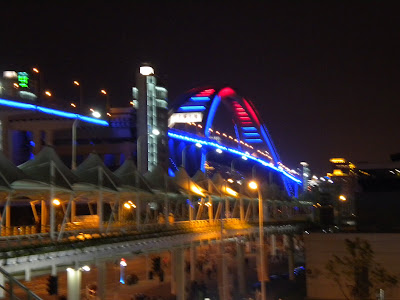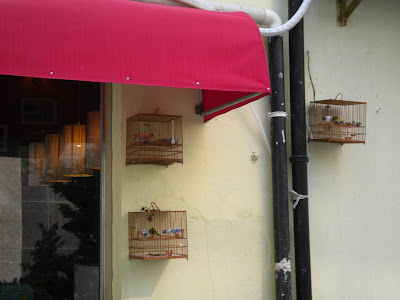[Sunday May 30 Evening]-- The architecture and sites of Shanghai is fascinating by day, but the city really comes alive at night. One of its features are the lights that are on every major bridge and building in the city. An area in the oldest part of the city is called The Bund. This area was the center of commerce, and location of many of the wharfs along the river. The area frequently flooded, and so a levee was built to protect the city. The levee is called The Bund (literally translated, "the beach"). There are many old buildings in this area, as well as new. The government has taken steps to protect and restore these heritage architectures. On the far side of the river (Pudong district) there are many new buildings and tower. As you can see, they are lit colorfully. (One tall downtown building has search lights at night-- I thought we might actually be in Gotham City!)

Chinese Dinner-- While in Shanghai we were hosted for a dinner by an HP acquaintance in Shanghai and HP friends from Singapore, who happened to be in Shanghai at the same time. From left to right: Sunny (HP employee in Shanghai), Karen (works with Elaine in Singapore), Matthew, Dr. "Zinny" Ho (Karen's husband), Elaine, and Jim.
Elaine, Jim on The Bund, Shanghai

The Bund Walkway-- Just a few folks out enjoying the incredible lights of Shanghai from The Bund. This picture was taken about 23:00.
River Cruiser-- A river cruiser competes for attention among the lights along the Bund.
Dragon Boat-- This one grabbed my attention...
Large scale digital imagery
Discotheque-- This odd shaped building along the Bund has an outdoor disco on the top floor.
New-- The blueish lit building in the background is a recent addition to Shanghai. It is one of the tallest buildings in the world. There is an open area near its top, with a sky bridge connecting the two towers. The sky bridge has a glass floor. We didn't get to go in the building, but its construction was featured on The Discovery Channel.
Old-- circa 1920's on The Bund

When you are walking along the Nanjing Road pedestrian mall (and nearly anywhere else in the Bund area) you can expect to be constantly approached by touts and hucksters-- people who are selling counterfeit merchandise. This is particularly true if you are obviously a Westerner. (Some friends from Singapore had no experiences with touts). Some of the touts are only trying to sell laser pointers or strap-on roller skates that light up. However most have small laminated brochures with dozens of pictures of the many wares they are peddling. "Shop-ping! You want bags, watch, i-Phone, T-shirt?" Some can be quite persistent, following you along the walkway for quite a distance. We declined to participate in this black market-- not sure what kind of "deals" you might get. In general (legitimate) prices are very inexpensive in Shanghai, which was a very pleasant relief from Singapore, which is very expensive. There are police officers everywhere, but there appears to be tolerance to the touts.
But not entirely. On our return to our hotel from The Bund, we witnessed a tout selling counterfeit Expo 2010 merchandise being rousted by the police. (Looked like Haibo key chains) A police officer chased after him and confiscated his goods. Seeing this, a number of other touts starting running away, with their bogus Expo 2010 wares. There are apparently certain limits to tolerating counterfeiting goods, that when crossed, bring about law enforcement.
Counterfeiting seems to be a common problem, and not just with counterfeit goods. We learned that counterfeit currency (The Yuan also know as RMB) is a big problem in the PRC-- the 100 Yuan note is a popular target. So much so that most hotels, businesses, and certainly banks have scanning machines that are used when the merchants are presented with 100 Yuan or larger notes to detect the counterfeits.
Nanjing Road-- A casual stroll down Nanjing pedestrian mall at night.
Billboard?-- What appears as a billboard is actually the side of a hotel. Through changing lights different images are displayed, visible from the Nanjing Road pedestrian walk.
Moments later, a new image...
Bronze sculpture along the mall






















































